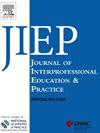Exploring interprofessional collaboration practices in dementia day centers
Q3 Social Sciences
Journal of Interprofessional Education and Practice
Pub Date : 2025-08-28
DOI:10.1016/j.xjep.2025.100764
引用次数: 0
Abstract
Background
The growing prevalence of dementia due to population ageing has increased the demand for comprehensive, high-quality care. Interprofessional collaboration (IPC) has been shown to enhance outcomes for people with dementia, yet its implementation varies across settings. Dementia day centers provide a unique opportunity to examine IPC in practice within coordinated, multi-professional care environments.
Objectives
The study aimed to evaluate the extent to which professionals working in dementia day centers adhere to IPC standards and explore whether demographic and employment-related factors influence perceived adherence to these standards.
Methods
A questionnaire evaluating adherence to IPC standards was administered to 50 healthcare professionals. Multiple linear regression analysis was conducted to examine the association between adherence to IPC standards and participants' characteristics. The Friedman test was employed to compare the questionnaire's subscales and the Kruskal-Wallis test to compare perceived adherence to standards across demographic and employment-related subcategories. Responses to two open questions were analyzed using thematic analysis.
Results
Thirty-four professionals responded to the survey. Employment facility significantly contributed to the prediction of the regression model. Overall, participants had a positive perception of the adherence of clinical practices to IPC standards. Notably, role delineation was identified as a major IPC barrier.
Conclusion
This study supports the use of an IPC evaluation tool in day centers for identifying and addressing areas of low compliance to standards and maximize benefits for patients and healthcare professionals. IPC practices may vary across clinical settings even within the same organization.
探索痴呆症日间中心的跨专业合作实践
由于人口老龄化,痴呆症的患病率不断上升,这增加了对全面、高质量护理的需求。专业间合作(IPC)已被证明可提高痴呆症患者的治疗效果,但其实施情况因环境而异。痴呆症日间中心提供了一个独特的机会,在协调的多专业护理环境中检查IPC的实践。本研究旨在评估痴呆日间中心工作的专业人员遵守IPC标准的程度,并探讨人口统计学和就业相关因素是否会影响对这些标准的遵守程度。方法对50名卫生保健专业人员进行IPC标准依从性评价问卷调查。采用多元线性回归分析来检验遵守IPC标准与参与者特征之间的关系。弗里德曼测试被用来比较问卷的子量表和Kruskal-Wallis测试来比较在人口统计和就业相关的子类别中对标准的遵守程度。对两个开放性问题的回答采用主题分析进行分析。结果34位专业人士参与了调查。就业便利对回归模型的预测有显著贡献。总体而言,参与者对临床实践遵守IPC标准有积极的看法。值得注意的是,角色划分被确定为主要的IPC障碍。结论:本研究支持在日托中心使用IPC评估工具来识别和解决不符合标准的领域,并最大限度地为患者和医疗保健专业人员带来好处。即使在同一组织内,IPC实践也可能因临床环境而异。
本文章由计算机程序翻译,如有差异,请以英文原文为准。
求助全文
约1分钟内获得全文
求助全文
来源期刊

Journal of Interprofessional Education and Practice
Social Sciences-Education
CiteScore
1.60
自引率
0.00%
发文量
80
期刊介绍:
Journal of Interprofessional Education & Practice, a quarterly online-only journal, provides innovative ideas for interprofessional educators and practitioners through peer-reviewed articles and reports. Each issue examines current issues and trends in interprofessional healthcare topics, offering progressive solutions to the challenges facing the profession. The Journal of Interprofessional Education & Practice (JIEP) is affiliated with University of Nebraska Medical Center and the official journal of National Academies of Practice (NAP) and supports its mission to serve the public and the health profession by advancing education, policy, practice & research.
 求助内容:
求助内容: 应助结果提醒方式:
应助结果提醒方式:


